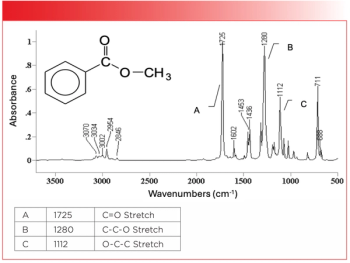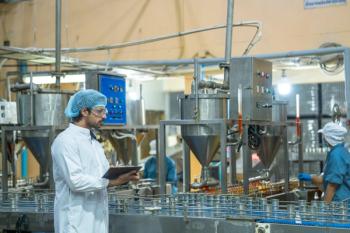
Rapid, Portable Mid-Infrared Spectroscopy Identifies Aflatoxins in Peanuts
Researchers have developed a portable mid-infrared (IR) spectroscopic method combined with chemometric analysis to rapidly and non-destructively detect aflatoxin contamination in Aspergillus-infected peanuts. This approach offers a field-deployable alternative to traditional wet chemistry methods, with high sensitivity and specificity in identifying toxic metabolites such as aflatoxins.
Aflatoxin contamination in food products, particularly peanuts, poses significant health risks due to its carcinogenic properties (1–3). Aspergillus flavus and Aspergillus parasiticus, common soil fungi, produce these toxins, making rapid detection crucial for food safety. Conventional methods like high-performance liquid chromatography (HPLC) and liquid chromatography-tandem mass spectrometry (LC–MS/MS) are effective but time-consuming, costly, and require complex sample preparation. In response, a research team led by Siyu Yao, Jake Fountain, Luis E. Rodriguez-Saona, and colleagues from Southeast University in China, The Ohio State University, the University of Georgia, and Mars Wrigley have developed a novel, field-deployable Fourier transform infrared (FT-IR) spectroscopy system. This system, integrated with advanced chemometric modeling, enables rapid and non-invasive detection of aflatoxin contamination in peanuts (1).
Study Methodology and Findings
The study involved the inoculation of 274 peanut kernels with Aspergillus flavus (NRRL 3357 and AF13 strains). Using a portable FT-IR spectrometer, researchers collected spectral data from the peanut surfaces. These spectral readings were then analyzed using chemometric techniques, including orthogonal partial least squares discriminant analysis (OPLS-DA) and soft independent modeling of class analogies (SIMCA), to classify contaminated samples. The accuracy of these methods was validated as compared to reference results obtained using ultrahigh-pressure liquid chromatography-tandem mass spectrometry (UHPLC–MS/MS) (1).
A key breakthrough in the study was the detection of aflatoxin M1 in A. flavus-infected peanut kernels, confirmed through spectral fragmentation analysis. Classification models developed using OPLS-DA and SIMCA demonstrated high sensitivity (94.7%) in identifying peanuts with aflatoxin levels exceeding 3 parts per billion (ppb). Furthermore, partial least Squares regression (PLSR) models yielded a strong prediction set correlation (Rpre = 0.85) and excellent residual predictive deviation (RPD = 6.2) in quantifying aflatoxin levels, demonstrating the method's robustness (1).
Spectroscopic Analysis and Chemometric Modeling
Spectral analysis revealed distinct molecular signatures in infected peanut kernels, allowing differentiation based on toxin presence. The study found that traditional attenuated total reflectance Fourier transform-infrared spectroscopy (ATR FT-IR) techniques, where IR energy penetrates about 10 microns into the surface, were still effective in capturing spectral changes associated with fungal infection. The research also highlighted the importance of the 3600-3100 cm-1 spectral range for detecting surface moisture and the 1300-900 cm-1 region for identifying carbohydrate and phenolic compound alterations due to fungal metabolism (1).
Chemometric models played a crucial role in refining detection accuracy. SIMCA and OPLS-DA classification models exhibited superior predictive capabilities, with validation tests showing 89.6% and 86.2% accuracy, respectively. These models effectively distinguished between contaminated and non-contaminated peanut samples, even when aflatoxin levels were at regulatory limits. Compared to previous studies using benchtop FT-IR systems, the portable approach demonstrated comparable, if not superior, classification accuracy (1).
Advantages and Future Implications
The integration of FT-IR spectroscopy with advanced predictive algorithms offers an advancement in food safety monitoring. Unlike traditional methods that require extensive sample processing, this approach provides near-instantaneous results with minimal sample preparation. The field-deployable nature of the system makes it ideal for routine in-plant aflatoxin screening, potentially reducing costs and increasing compliance with food safety regulations (1).
Future research aims to expand the model to include additional peanut varieties and Aspergillus morphotypes, improving robustness across diverse contamination scenarios. Advancements in machine learning (ML) and signal processing could further enhance classification accuracy and detection sensitivity. With continued innovation, this technology could revolutionize non-destructive, high-throughput screening for food contaminants, benefiting both regulatory agencies and the food industry (1).
This study demonstrates the feasibility of using portable FT-IR spectroscopy combined with chemometrics to detect aflatoxin contamination in peanuts rapidly and accurately. The proposed method provides a scalable and cost-effective alternative to traditional analytical techniques, potentially transforming food safety protocols by enabling real-time, in-field detection of toxic fungal metabolites.
References
(1) Yao, S.; Fountain, J.; Miyagusuku-Cruzado, G.; West, M.; Nwosu, V.; Dowd, E.; Giusti, M. M.; Rodriguez-Saona, L. E. Portable Mid-Infrared Spectroscopy Combined with Chemometrics To Detect Toxic Metabolites, Aflatoxins in Aspergillus-Infected Peanuts. LWT 2025, 215, 117186. DOI:
(2) National Cancer Institute. Aflatoxin Web Page.
(3) Gong, Y. Y.; Watson, S.; Routledge, M. N. Aflatoxin Exposure and Associated Human Health Effects: A Review of Epidemiological Studies. Food Saf. 2016, 4 (1), 14–27. DOI:
Newsletter
Get essential updates on the latest spectroscopy technologies, regulatory standards, and best practices—subscribe today to Spectroscopy.




